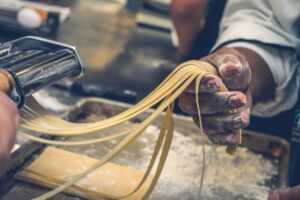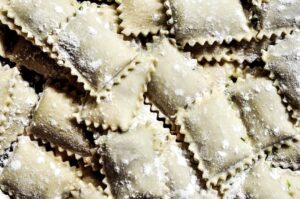Pasta: Let’s set the record straight from the beginning: the invention of pasta cannot be credited to the Chinese, and it did not find its way to Italians through Marco Polo. Instead, its origins can be traced back to Arab Sicily, from where it gradually spread throughout Italy, making notable stops in Naples and Genoa. This is the intriguing tale behind the dish that symbolizes Italian cuisine.
It’s challenging to find a more emblematic and universally beloved symbol of Italian culture. Yet, pasta hasn’t always received the respect it deserves. From derogatory terms like “macaroni” and “spaghetti-eaters” aimed at our emigrants to Filippo Tommaso Marinetti’s Futurist decree advocating nothing less than “the abolition of pastasciutta, an absurd Italian gastronomic religion,” labeling it a symbol of a “heavy” tradition and an image of a sluggish and indolent Italy, in other words, a “passatista” living in the past. This was in stark contrast to the Futurist belief that “men who are poorly or coarsely fed have achieved great things in the past.”
Its Ancestry
The history of pasta is a story of transformation, from the wheat fields to the dinner table. Yet, the question of its origins is not easily answered, especially for a dish as simple and popular. What is known is that even ancient civilizations like the Romans, Greeks, and Etruscans had their early versions of lasagna, or “lagana” – thin pasta sheets filled with meat and baked in the oven.
To find something resembling our modern pasta, one must journey to the end of 1154 when the Arab geographer Edrisi described a food made of flour in the form of threads called “triyah” (derived from the Arabic “itrija”). This one was made in Trabia, near Palermo in Sicily, and it was exported in barrels across the Italian peninsula.
The Birthplace: Palermo and Its Surroundings
Even today, in Sicily, references to “vermiceddi di tria” (vermicelli) or “tria bastarda” can be heard. Puglia, another region briefly under Arab rule, also has its own traditions, including “massa e tria,” “tria e ciceri” (a variant and chickpeas typical in Salento), and “tridde” or “triddi.” Edrisi’s accounts make it clear: dry , suitable for long-term storage and transport, was born in the sunny and windswept western regions of Sicily during the Arab rule. The Arabs, who may have known dry even before their conquest of the island, found it especially useful for ensuring food supplies during their desert journeys.
A Focus on Northern Italy
One thing is evident: pasta was well-known in Italy long before Marco Polo’s return from China in 1295 and his tales of Chinese “spaghetti.” By the 12th century, Genoese merchants had introduced pasta from western Sicily to northern Italy, including the areas around Genoa, Trapani, and the ancient gastronomic connections between the two regions. These pastas, cooked for longer durations than what we now consider “al dente,” were paired with a variety of condiments. Generally, they were served with generous amounts of grated cheese and powdered spices. Among the aristocracy, pasta was considered a side dish, while for the common people, it was often the main course.
The Vesuvius Region
The production of pasta began to spread, moving north throughout southern Italy and Liguria. The dry and windy climates in places like Gragnano, Torre Annunziata, and Puglia favored air drying. In other parts of Italy, the production of egg pasta persisted, likely influenced by the Roman “lagana.” However, although pasta was widespread, it wasn’t yet a staple.
It was only in the 17th century, in the bustling city of Naples – Europe’s largest at the time – that pasta truly became a mass dish. Demographic pressures and excessive taxation by the Spanish authorities led to a collapse in meat and bread consumption, pushing the population toward pasta. Technological advancements made production more affordable. By the 18th century, Neapolitans had earned the nickname “mangia-maccheroni” (a title previously reserved for Sicilians), and pasta began to symbolize a national dish, a quintessential, economical, and popular Italian food.
During this period in Naples, the classic pairing of pasta with tomato sauce was created, forever linking these two culinary staples. Just before the annexation of the Kingdom of the Two Sicilies, when Italy was first being unified, Cavour wrote, “The macaroni are cooked, and we will eat them.”
This marked a moment when pasta became an integral part of Italy’s cultural identity, a symbol of unity among diverse regions.
Contact us today and join the Italian Language School


